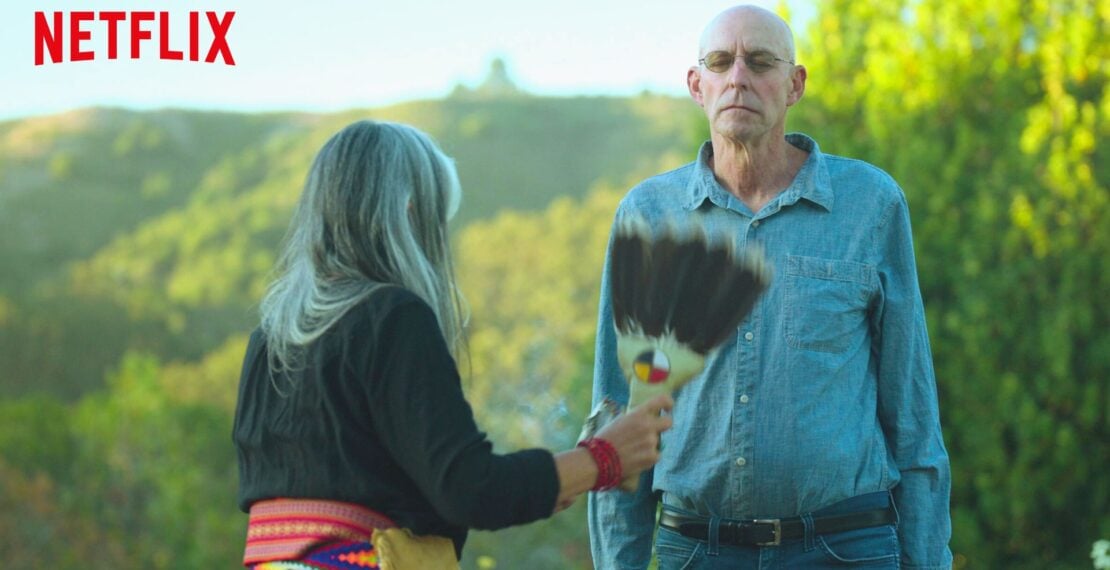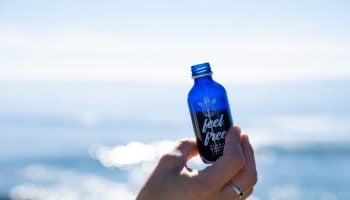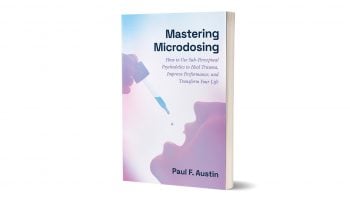DISCLAIMER: The medicines discussed in this review article are potentially illegal substances, and we do not encourage or condone the use of these substances where it is against the law. However, we accept that illegal drug use occurs and believe that offering responsible harm reduction information is imperative to keeping people safe. For that reason, the resources linked in this review are designed to enhance the safety of those who decide to use these substances.
Word wizard and author Michael Pollan has arguably done more to propel the third wave of psychedelics than any modern influencer. His 2015 essay, “The Trip Treatment”, followed by his No. 1 New York Times best-selling book, How to Change Your Mind, inspired unlikely psychonauts worldwide to rethink preconceived notions about psychedelics. He did this by putting people’s ineffable journeys and life-changing outcomes into stories that compelled grand-scale curiosity.
So it was only natural that the award-winning author and investigative journalist partnered with Netflix as his next conduit to amplify the message. With the world’s largest streaming service as the microphone, executive producers Michael Pollan and Alex Gibney released the documentary series, How to Change Your Mind, covering the history and use of LSD, psilocybin, MDMA, and mescaline.
Released on July 12th by acclaimed directors Alison Ellwood and Lucy Walker, How to Change Your Mind’s popularity is yet to be determined. So far, it hasn’t appeared on Netflix’s top 10 documentaries list and only a handful of Rotten Tomatoes critics have left lukewarm reviews. Still, with an 8/10 IMDb rating, a glowing review from The Guardian, and 221 million Netflix subscribers, it’s safe to say Pollan’s series has time to spread while the streaming service’s algorithm works its magic.
The bigger question is, does the How to Change Your Mind Netflix documentary offer sufficient substance, intrigue, and evidence to appease psychedelic fans while shifting the minds of skeptics?
More importantly, will it inspire the masses to invest four hours learning about the psychedelic renaissance when they could be watching TV shows like Stranger Things instead?
Here’s our take.
How to Change Your Mind Documentary Review
Episode 1: LSD
Short take: an episode for history buffs
Long take:
I can see how Pollan’s opening scene snuffing ceremonial tobacco alongside chanting wisdom keeper, Erika Gagnon, might confuse anyone pressing play on the LSD episode. But those who continue watching will thoroughly understand LSD’s history and leading role in Nixon’s war on drugs. Hopefully, they’ll also gain insights into the flourishing field of LSD research today.
Perhaps an apt introduction to the series, Pollan spends most of the first episode diving into LSD’s rich and recent history. He devotes a large segment to scientist Albert Hofmann’s accidental LSD discovery in 1938, followed by Hofmann’s transformative heroic dose years later. The visual portrayal of Hofmann’s reality-warping journey was terrifying, making me wonder if it would scare off mainstream viewers. But when Pollan explains that Hofmann’s nightmarish trip induced enlightenment, which snowballed into a widespread research movement, I felt confident that Pollan responsibly toed the line between LSD’s mind-bending and enhancing qualities.
Pollan then explains how renowned therapists from 1950-1965 tested LSD on thousands of patients, proclaiming it as a miracle treatment for mental illness. But he never cites any of these studies. Instead, Pollan quickly shifts gears to LSD’s counterculture downfall and federal ban, which he links partly to advocate Timothy Leary. Viewers learn that Leary, a former Harvard professor who conducted less-than-scientific LSD studies and coined the phrase “turn on, tune in, drop out”, inadvertently helped destroy the substance’s credibility.
Pollan narrates LSD’s rise and fall before transitioning to its benefits for creativity, neuroplasticity, and mental health. He attributes the invention of vaccines and computers to LSD revelations. He talks about how LSD opens the mind to reexperiencing childlike wonder. He interviews a friend and fellow writer who describes how microdosing LSD helped her escape suicidal thoughts. He ensures viewers understand how serious LSD really is for mental health and cognitive enhancement.
Still, I wanted more. I wanted Pollan to discuss the MAPS-sponsored clinical study on LSD-assisted therapy, and I wanted an expansive conversation on the burgeoning field of microdosing research. I wanted so much more from this episode than it could’ve feasibly provided in under an hour. Acknowledging this bias, I asked a couple of baby boomers and skeptics to weigh in on their takeaways.
“I had no idea LSD wasn’t addictive. I believed everything bad I was taught about LSD for the brain and body in the 70s.” – Sherry S.
“The part about Silicon Valley inventors designing computers from LSD experiences was fascinating.” – Penny R.
“I was really interested in learning about how the government controlled us and educated us about the drug [LSD] in the 60s.” – Scott R.
Satisfied with their responses, I quickly realized this docuseries couldn’t be everything to everyone. For more adept psychonauts, there are plenty of resources online already (like Third Wave’s LSD guide) that take a deeper dive into this medicine. But the first episode of How to Change Your Mind must be worth the watch if it can convince people who grew up with anti-drug indoctrination that LSD is potentially a therapeutic substance. So, I adjusted my expectations and trusted in Pollan’s storytelling wizardry.
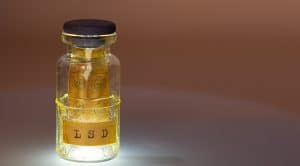
Microdosing Can Help With Depression. Here’s how to do it right.
It’s more than just “medicine”, it’s a process. Get our FREE guide for microdosing for depression and discover what’s possible for you.
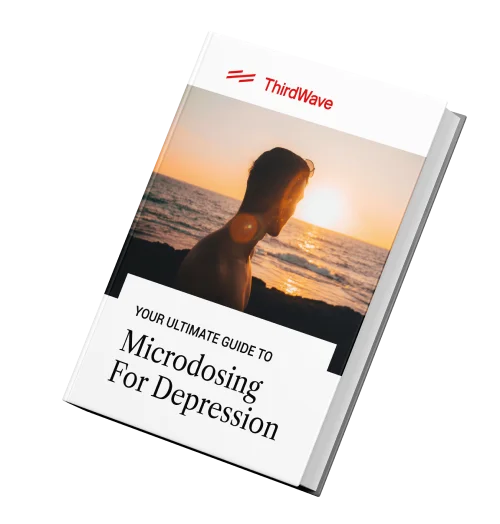
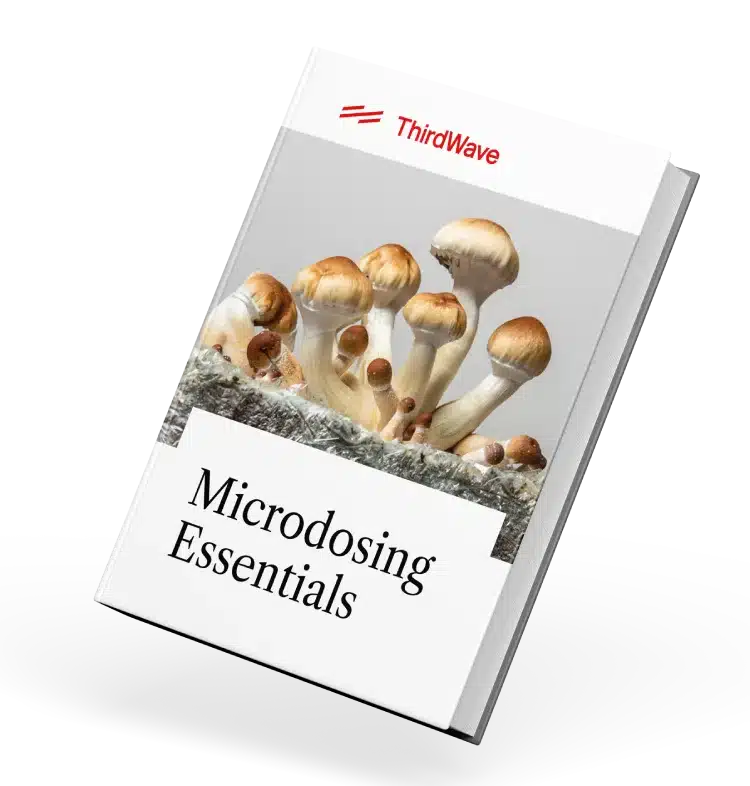
Microdosing Can Help With Depression. Here’s how to do it right.
It’s more than just “medicine”, it’s a process. Get our FREE guide for microdosing for depression and discover what’s possible for you.
Episode 2: Psilocybin
Short take: an episode for the spiritually curious
Long take:
Pollan’s magic mushroom quest feels genuine considering his career writing about the intersection of nature and humanity in top sellers like The Botany of Desire, Food Rules, and The Omnivore’s Dilemma. Pollan’s passion shines through in scenes featuring slow-motion mycelial growth and mystical journeys so vivid that viewers could mute the TV and understand precisely what’s occurring. Perhaps that’s why I found this episode the most captivating and visually stunning.
Pollan devotes time to discussing historical sacred use in every chapter. But this was the only episode that combined spiritual traditions with modern spiritual transformations.
For instance, Pollan interviews a 78-year-old Catholic cancer patient, Kathleen Krall, who found peace after feeling eternal love from the Virgin Mary during a mushroom session. He also spoke with a young man, Ben, who claimed to have cured himself of OCD through a psilocybin journey that entailed a death and rebirth experience.
In the episode, Pollan beautifully weaves in psilocybin’s indigenous history as well. He dedicates a large segment to the Mexican healer Maria Sabina who helped introduce magic mushrooms to the West in 1950 alongside JP Morgan Banker and amateur mycologist R. Gordon Wasson. The segment felt like a much-needed nod to an unknown icon who’s indirectly responsible for healing countless people.
Before Maria Sabina sparked the movement that ultimately led to this docuseries, most had no idea that the occasional garden variety mushroom could combat the most rigid mental illnesses. To give credence to the claim, Pollan interviews psychopharmacologist Dr. Roland Griffiths, who explains that mushrooms elicit change, in part, by breaking down the brain’s default mode network (DMN). This mechanism allows people to reframe their stories and let go of maladaptive patterns. Griffiths states in cold hard terms that mystical psychedelic experiences have scientific definitions and are one of the most significant predictors of the fungi’s success at helping individuals cure their emotional and physical ailments.
For Krall and Ben, this was undoubtedly the case.
“I died. Completely. I became dirt. I felt what it was like to be dirt. And I slowly grew…. into a tree. I watched my human self and wife and child and dog walk by. My human self grabbed a twig of me and played with it. Suddenly I snapped back from being a tree into my human body, and everything I ever lived came back to me,” says Ben.
After re-experiencing his entire life, Ben proclaimed himself cured of OCD. It was an incredible statement to make. I couldn’t believe it. At that moment, I thought, Pollan could’ve spent an hour covering this one story, and I probably would’ve been satisfied with the content. But combined with expert interviews, anecdotes, and historical accounts, I thought this might be the best one of the series. So, I enlisted my focus group once more to find out what they thought.
“The fact that one or two psilocybin treatments can change or save someone’s life is truly amazing.” – Sherry S.
“I understand the medical value, but I feel more connected to the spiritual aspect. I’ve always felt there is a connection amongst all things. And it seems obvious that the answer is found in nature.” – Mara R.
“I tried psilocybin recreationally in college, but I had a very different mindset then. This show makes me consider revisiting it, not to ‘trip out,’ but to take a step back, reflect, and see if I can find a new perspective on my life today.” – Elan R.
For others who find themselves in this camp, Third Wave’s psilocybin mushrooms guide or mushroom grow kit would be helpful resources.
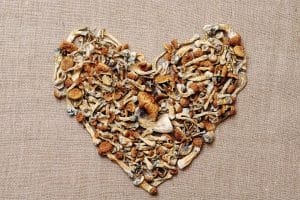
Grow 1 Year's Worth of Microdoses in Just 6 Weeks
Third Wave partnered with top mycologists to create the world’s easiest and best mushroom growing program (kit, course, and expert support).
- Pre-sterilized and sealed
(ready to use out of the box) - Step-by-step video and text course
- Access to growing expert in community
- Make your first harvest in 4-6 weeks
- Average yield is 1 - 4 ounces (28-108g)
- Fits in a drawer or closet
- Enter info for Third Wave discounts:
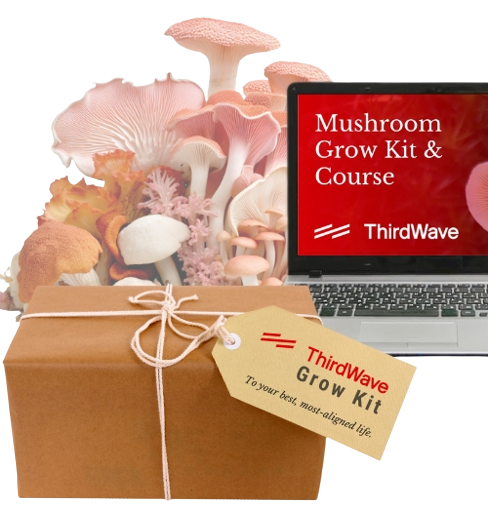
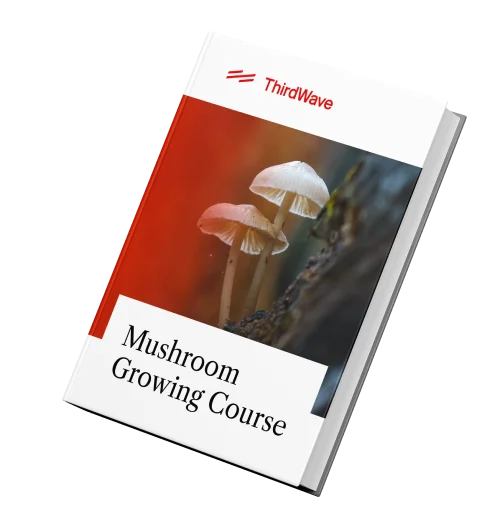
Grow 1 Year's Worth of Microdoses in Just 6 Weeks
Third Wave partnered with top mycologists to create the world’s easiest and best mushroom growing program (kit, course, and expert support).
- Pre-sterilized and sealed
(ready to use out of the box) - Step-by-step video and text course
- Access to experts in community
- Make your first harvest in 4-6 weeks
- Average yield is 1 - 4 ounces (28-108g)
- Fits in a drawer or closet
- Enter info for Third Wave discounts
Episode 3: MDMA
Short take: an episode for the evidence-based mind
Long take:
I believe this episode won the day for people who wanted less history and mystery and more data-driven narratives. The tone shift is a byproduct of the fact that MDMA doesn’t date back to indigenous Amazon tribes, Native Americans, or even Timothy Leary. In 1912, pharmaceutical company Merck created MDMA.
However, psychotherapists didn’t know of it until a chemist, Sasha Shulgin, synthesized the compound in the 1970s. Sasha saw MDMA as an effective therapeutic to improve relationships and a person’s connection with themself. So, Sasha and his wife Ann Shulgin began distributing MDMA to therapist friends, who quickly adopted it into their underground practices.
Viewers then learn that MDMA does not exhibit the traditional effects of psychedelics like LSD and psilocybin. MDMA doesn’t dissolve the brain’s default network or elicit mystical visual journeys. Instead, it works in a more direct way.
Ann Shulgin, whose recent passing is still being mourned, explains, “…[MDMA] allows you to see who you are without a self-rejection. That’s what it’s for, for insight… and is especially good for PTSD,”
Despite its utility, Pollan explains that MDMA’s rave culture spread, and subsequent demonization led it to the same legal fate as other psychedelic drugs. At this point in the episode, Pollan introduces viewers to the man changing the course of psychedelic history: Rick Doblin.
I couldn’t help but feel excited when Doblin entered the story. After all, Doblin’s organization, the Multidisciplinary Association for Psychedelic Studies (MAPS), has sponsored research for over three decades, yet most people have no idea who he is. This segment ensures mainstream viewers understand that MDMA’s clinical outcomes have been so successful that MDMA is approaching FDA approval.
Fortunately, Doblin’s segment also drops much-needed knowledge surrounding MDMA’s brain-damaging reputation. Even as a psychedelics student of the science of psychedelics, I had no idea that this fear-mongering claim was based on a scandalous neuroscience study that was retracted in 2003.
Still, I found the most convincing aspect of this episode was the scenes portraying MAPS’ Phase III MDMA therapy sessions in action.
These scenes gave people an invaluable peek behind the curtain to witness psychedelic therapy unfold. Mystery begone, viewers watched PTSD patients, like Lori Tipton, in her rawest, most vulnerable form. The audience saw Lori process traumas from Hurricane Katrina to her brother’s death, to her mother’s suicide, and her own rape and abortion. And after three MDMA sessions, Lori began living life fully again.
Retired Sgt. Jonathan Lubecky also suffered from PTSD, joining the MAPS study after chronic nightmares, lack of sleep, and growing stress. Like Lori, Sgt. Lubecky proclaimed that MDMA therapy saved his life.
In the end, episode three provides significant hope for MDMA proponents while delivering enough data to convince the greatest skeptics.
For those interested in learning more about this powerful substance, Third Wave’s MDMA guide is an informative resource.
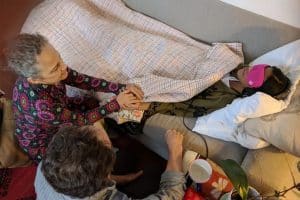
Microdosing Can Help With Depression. Here’s how to do it right.
It’s more than just “medicine”, it’s a process. Get our FREE guide for microdosing for depression and discover what’s possible for you.


Microdosing Can Help With Depression. Here’s how to do it right.
It’s more than just “medicine”, it’s a process. Get our FREE guide for microdosing for depression and discover what’s possible for you.
Episode 4: Mescaline
Short take: an episode for the socially conscious
Long take:
Pollan didn’t explore mescaline in his Penguin Press edition of How to Change Your Mind. In hindsight, he felt that was a disservice. So in the final episode, Pollan expresses the need to showcase this “orphan psychedelic” almost exclusively from the Native American perspective. For the socially conscious viewer, this episode was paramount.
Pollan immediately introduces viewers to Native American Church members who describe peyote as a spiritual teacher. According to their accounts, peyote allows them to speak with God, connect with ancestors, collectively heal from colonial trauma, and treat mental and physical illnesses.
Pollan interviews Julius Not Afraid (Apsáalooke) & Oglala Lakota tribes, describing how sacramental peyote helped him overcome addiction and depression. Pollan then homes in on how Native Americans’ relationship with peyote has been in peril since European colonists and Spanish conquistadors arrived 500 years ago. Pollan shows that despite historical oppression, Native Americans never ceased to fight for their religious right to consume peyote, which Bill Clinton finally codified in the 1990s.
But today, Native Americans feel the threat looming again—this time from advocates who seek to decriminalize psychedelic plants. Pollan explains many Native Americans’ fear that if the government decriminalizes peyote for all citizens, hordes of people will invade their lands and poach their spiritual teachers.
In the end, Pollan takes a stand. He tells viewers we should not seek peyote as our source of mescaline. Instead, we should embrace synthetic or San Pedro-based mescaline, which grows more quickly and rampantly, and which you can learn more about in this Third Wave guide to San Pedro.
Pollan’s right. I believe his message of indigenous respect was something everyone needed to hear. At the same time, I couldn’t help feeling the episode left most people without a tangible understanding of mescaline’s properties, benefits, or effects. Aside from highlighting Aldous Huxley’s mescaline depiction in the famous book Doors of Perception, Pollan leaves much to the imagination.
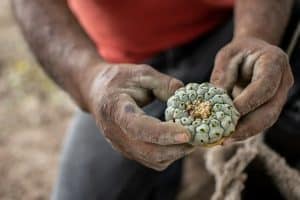
Grow 1 Year's Worth of Microdoses in Just 6 Weeks
Third Wave partnered with top mycologists to create the world’s easiest and best mushroom growing program (kit, course, and expert support).
- Pre-sterilized and sealed
(ready to use out of the box) - Step-by-step video and text course
- Access to growing expert in community
- Make your first harvest in 4-6 weeks
- Average yield is 1 - 4 ounces (28-108g)
- Fits in a drawer or closet
- Enter info for Third Wave discounts:


Grow 1 Year's Worth of Microdoses in Just 6 Weeks
Third Wave partnered with top mycologists to create the world’s easiest and best mushroom growing program (kit, course, and expert support).
- Pre-sterilized and sealed
(ready to use out of the box) - Step-by-step video and text course
- Access to experts in community
- Make your first harvest in 4-6 weeks
- Average yield is 1 - 4 ounces (28-108g)
- Fits in a drawer or closet
- Enter info for Third Wave discounts
Final Takeaways
Michael Pollan took on the unsurmountable challenge of explaining vastly different psychedelics’ past, present, and future in four short hours. So I agree with the critics who say he tried to do too much.
For instance, Pollan mentions microdosing but barely scratches the surface on its prolific use and growing research. Additionally, he alludes to psychedelic drugs studies on “healthy volunteers” but spends very little time discussing the phenomena of adult use for personal growth.
Sadly, the importance of integration protocols for enduring change is patently and glaringly missing. Similarly, the implication that one dose of certain substances can entirely “cure” a pre-existing condition may drive some people to approach psychedelics with unreasonable (and unsubstantiated) expectations—laying the foundation for a potentially skewed mindset.
Additionally, in the last few minutes of the Netflix series, Pollan haphazardly mentions psychedelics could be the answer to the world’s environmental crisis without making any prior reference to this thesis.
Yet, despite the somewhat scattered narrative, Netflix’s How To Change Your Mind docuseries underscores many core Third Wave tenets, like:
- Psychedelics are not a panacea to all of life’s problems.
- Skill and intention are critical to seeing psychedelic benefits.
- The substances have the power to unveil mysteries of human consciousness.
- Psychedelics are tools for mindful transformation, not mindless trips.
- Responsible use is critical to the successful third wave of psychedelic acceptance.
What I loved most was that, despite supporting psychedelic freedom, Pollan falls purposely short of waving a flag for unfettered use. He doesn’t claim to be a guru who wants to spread transcendence through psychedelic drinking water.
Instead, he approaches the series as a humble student who deems psychedelics as neither good nor bad, but as tools for collective growth. And perhaps that unpretentious curiosity is precisely what’s required to change minds.
Disclosure: This article contains offers and affiliate links. Third Wave receives a small percentage of the product price if you purchase through affiliate links. Read our ethics and affiliates policy here.

